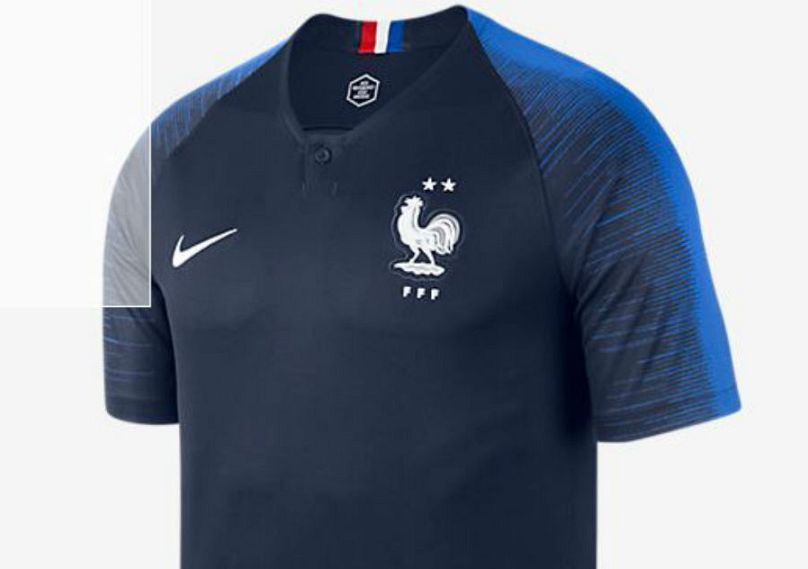An investigation by a French broadcaster revealed how much it costs Nike to produce the new two-star French football jersey. So what is behind Nike's fruitful production model? Euronews finds out.
Despite an already high demand, French football fans will have to wait a little longer to buy the new two-star jersey. The national team's official sponsor, Nike, announced last week that the shirt's production would start in August.
However, while fans eagerly await the release of the new jersey, little is known about how and where it will be made.
An investigation by a French radio broadcaster revealed that Nike was outsourcing the majority of the production to Thailand and that each shirt would cost them less than €3 to make.
Euronews spoke to Nayla Ajaltouni, who works as a coordinator for the French labour rights watchdog Collectif d'ethique sur l'etiquette, who's behind a higher pay campaign for factory workers.
Do we know in which countries and in which conditions France’s new jersey is being produced?
Unfortunately, we don’t have all the information concerning the countries where the jerseys are being produced nor the conditions Nike’s employees work in and that’s exactly what we are trying to find out from France’s sports sponsor. Other NGOs obtained information that various factories in Thailand were making the two-star jersey and that’s completely possible since Nike outsources production there.
Did Nike move its factories from China to Thailand?
Nike was already producing in Thailand but there’s been a shift in outsourcing for some time now. International sports companies have traded China, where salaries have gone up, for Southeast Asia, where salaries remain low and trade union rights are violated. The rhythm of work increases when there’s big demand from Europe — like there is now.
Reports are also saying that some jerseys are being made in Poland and Turkey
Nike has outsourced part of the production to these two countries to respond quickly to high demand and reduce shipping times. However, the group does not want to answer any questions concerning their social responsibility.
France’s radio station Europe 1 said an investigation by its leading news programme, le JDD, found that the production of each jersey cost Nike less than €3. However, these jerseys are sold at €80 or €140 in Europe. How is this possible?
We had a similar situation with the German jerseys in 2016. Labour costs are so low that they are marginal. Only 1% of the final price goes to workers who made the jersey.
Even though Nike doesn’t make a profit on everything because marketing and sponsoring costs are actually quite high, they’re still making a sizeable profit from the jerseys sold at €80 and €140.
Is the sale of the football jerseys a good thing for Thailand?
The biggest winners of the sales are Nike and its investors who have put in place the following sales strategy: bet considerable sums in the marketing of its image through sponsoring contracts with star football players and big teams, all the while ignoring work conditions of those making the clothing. The added value is kept in the United States and the low-cost value stays in countries where salaries are minimal in order to generate high margins and important profits. The losers are the workers who are at the bottom of the supply chain.
Is Nike the only brand who’s adopted this model or have other multinational companies adopted a similar business plan?
Adidas and others have copied Nike’s profit strategy. When Nike signed with Cristiano Ronaldo, Adidas fought hard to keep Lionel Messi. Other brands are trying to imitate Nike’s business model because they see how much money they make. In Wall Street, there’s the big four tech companies and Nike.
Is any jersey produced ethically?
There is sporting equipment produced under the fair trade label and we encourage it. But all big sporting companies are under a similar economic model — based on weak production costs and strong investment on marketing.
Nike and Adidas equipped 22 out of the 32 national teams qualified for this year’s World Cup.
A lot of French people are proud of the second star. Should they be buying the shirts despite the low remuneration factory workers receive?
The sense of national pride is understandable. Mbappe said he would donate all the money he received from the World Cup to NGOs and some of his teammates said the same. But Nike shouldn’t be making so much profit on the back of workers' exploitation. Each of us has to decide, knowing it is easy to call out these big brands who care a lot about their image on social media.
Euronews has reached out to Nike for comment.












